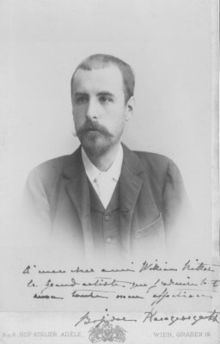Mother Sarka Anastasijevic Signature | Name Prince Karageorgevitch House Karadordevic dynasty | |
 | ||
Born 11 January 1862 ( 1862-01-11 ) Father Prince George Karadordevic Died April 2, 1908, Versailles, France Parents Sarka Anastasijevic, Prince George Karadordevic | ||
Prince Bojidar Karageorgevitch (Serbian: Божидар Карађорђевић/Božidar Karađorđević; 11 January 1862 – 2 April 1908), Serbian artist and writer on art, world traveller, and member of the Serbian Karađorđević dynasty. He gave singing and drawing lessons and later earned his living as an art critic and translator. He was a contributor to the Encyclopædia Britannica, Le Figaro, La Revue de Paris, Revue des Revues, Magazine of Art, and other publications.
Contents

Life account
Prince Bojidar belonged to the senior line of the Karađorđević dynasty. He was the second son of Prince George Karageorgevich and his wife Sarka Anastasijević (his older brother was Prince Alexis Karageorgevich). His grandfather Prince Aleksa was the eldest son of Karađorđe Petrović, the founder of the House of Karađorđević and leader of the First Serbian Uprising.
Prince Bojidar lived in France for most of his life as the members of the Karađorđević dynasty were in exile after Prince Alexander Karađorđević lost the Serbian throne in 1858. Bojidar travelled a lot and went on a number of trips around the world. He served in the French Army and fought in the French campaign at Tonking and was decorated with the Cross of the Legion of Honour. To earn a living he gave singing and drawing lessons before becoming a translator and journalist. He visited Serbia twice at the turn of the century (1897 and either late 1899 or early 1900), both times semi-incognito, trying to evaluate the general feel in the population about a possible replacement of the Obrenović dynasty with the Karađorđevićs should King Alexander Obrenović die childless, as was expected to happen at the time, due to the King's marriage with Queen Draga of an age beyond childbirth years at the time. He also visited Serbia once after his second cousin once removed King Peter I Karađorđević was enthroned but became disillusioned with the treatment he received (mostly ignored by his regal relative).
During one of his trips abroad, he travelled extensively around India, visiting thirty eight cities. He wrote a book about his experiences called Enchanted India in which he offered an account of the Indian people, their religious rites, and other ceremonies. He also provided detailed descriptions of the Indian landscape and buildings. He also translated works of Tolstoy and Hungarian dramatist Mór Jókai.
Taking an interest in art, he visited Munich, Dresden, and Berlin and spent some months in Italy; afterwards he settled at Paris. There he regularly contributed articles to the Figaro, La Revue de Paris, the Magazine of Art (Ilya Repin, Jules Bastien-Lepage), including a biography of Marie Bashkirtseff in the Encyclopædia Britannica, 11th Edition, Vol. III. Like all journalists he was drawn to the cabarets of Montmartre, the haunt of artists, writers, poets, philosophers. It was there he met and befriended French stage actress Sarah Bernhardt, pioneer of modern dance Loïe Fuller, French poet, novelist and noted orientalist Judith Gautier, Suzanne Meyer-Zundel, Austrian composer Hugo Wolf, painter and illustrator Henri de Toulouse-Lautrec, and founder of the Ballets Russes Sergei Diaghilev. Biographer Stevan K. Pavlowitch claims that the Prince was openly gay and had no relationship with women except purely platonic.
In his later years Prince Karadjordjevitch turned his attention in decoration, and executed panels and medallions for a Paris atelier as a designer, sculptor, painter and silversmith, and often spent time with Georges Lacombe, Émile Bernard, Paul Sérusier and other members of Les Nabis. Karageorgevitch's paintings, illustrations, watercolors and silversmith works were first exhibited in Belgrade in 1908.
As a journalist and a publicist he advocated the emancipation of all Slavs and Romanians under the Habsburg Monarchy; he also favoured the emancipation of the small states in the south-east of Europe, particularly Serbian lands, from Turkish supremacy. Prince Karadjordjevitch, who is known to a wider circle as a friend of writer Pierre Loti and the great Russian artist Marie Bashkirtseff, published some reminiscences, La Vie Multiple, and Notes sur L'Inde, both issued posthumously. Marie Bashkirtseff's friend since adolescence, Karadjordjevitch stood by her side during her last days and he was present at her deathbed. She was only 25 when she died, a victim of tuberculosis, in 1884. On the 20th anniversary of her death, in 1904 January edition of Revue des Revues, Karadjordjevitch would describe Bashkirtseff's last moments:
Marie rises a bit, releases a soft sigh, the sigh of tiny children when waking, and two thick tears roll down her cheek....then her head falls again into the pillow.
He died at Versailles on 2 April 1908.
Works
Media related to Prince Bojidar Karageorgevitch at Wikimedia Commons
